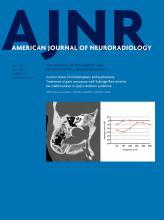Index by author
Booth, T.N.
- FELLOWS' JOURNAL CLUBHead and Neck ImagingYou have accessEvaluation of the Normal Cochlear Second Interscalar Ridge Angle and Depth on 3D T2-Weighted Images: A Tool for the Diagnosis of Scala Communis and Incomplete Partition Type IIT.N. Booth, C. Wick, R. Clarke, J.W. Kutz, M. Medina, D. Gorsage, Y. Xi and B. IsaacsonAmerican Journal of Neuroradiology May 2018, 39 (5) 923-927; DOI: https://doi.org/10.3174/ajnr.A5585
The second interscalar ridge notch angle and depth were measured on MR imaging in normal ears by a single experienced neuroradiologist. The images of normal ears were then randomly mixed with images of ears with incomplete partition II malformation for 2 novice evaluators to measure both the second interscalar ridge notch angle and depth in a blinded manner. For the mixed group, interobserver agreement was calculated, normal and abnormal ear measurements were compared, and receiver operating characteristic curves were generated. The 94 normal ears had a mean second interscalar ridge angle of 80.86° and depth of 0.54mm with the 98th percentile for an angle of 101° and a depth of 0.3 mm. In the mixed group, agreement between the 2 readers was excellent, with significant differences found between normal and incomplete partition type II ears for angle and depth on average. The authors conclude that a measured angle of >114° and a depth of the second interscalar ridge notch of ≤0.31 mm suggest the diagnosis of incomplete partition type II malformation and scalacommunis.
Borst, J.
- FELLOWS' JOURNAL CLUBNeurointerventionYou have accessAccuracy of CT Angiography for Differentiating Pseudo-Occlusion from True Occlusion or High-Grade Stenosis of the Extracranial ICA in Acute Ischemic Stroke: A Retrospective MR CLEAN SubstudyM. Kappelhof, H.A. Marquering, O.A. Berkhemer, J. Borst, A. van der Lugt, W.H. van Zwam, J.A. Vos, G. Lycklama à Nijeholt, C.B.L.M. Majoie and B.J. Emmer on behalf of the MR CLEAN InvestigatorsAmerican Journal of Neuroradiology May 2018, 39 (5) 892-898; DOI: https://doi.org/10.3174/ajnr.A5601
All patients from the Multicenter Randomized Clinical Trial of Endovascular Treatment for Acute Ischemic Stroke in the Netherlands (MR CLEAN) with an apparent ICA occlusion on CTA and available DSA images were included. Two independent observers classified CTA images as atherosclerotic cause (occlusion/high-grade stenosis), dissection, or suspected pseudo-occlusion. Pseudo-occlusion was suspected if CTA showed a gradual contrast decline located above the level of the carotid bulb, especially in the presence of an occludedintracranial ICA bifurcation (T-occlusion). In 108 of 476 patients (23%), CTA showed an apparent extracranial carotid occlusion. DSA was available in 46 of these cases, showing an atherosclerotic cause in 13 (28%), dissection in 16 (35%), and pseudo-occlusion in 17 (37%). The sensitivity for detecting pseudo-occlusion on CTA was 82% for both observers. The authors conclude that on CTA, extracranial ICA pseudo-occlusions can be differentiated from true carotid occlusions.
Boruah, D.K.
- Spine Imaging and Spine Image-Guided InterventionsYou have accessThe Importance of Flexion MRI in Hirayama Disease with Special Reference to Laminodural Space MeasurementsD.K. Boruah, A. Prakash, B.B. Gogoi, R.R. Yadav, D.D. Dhingani and B. SarmaAmerican Journal of Neuroradiology May 2018, 39 (5) 974-980; DOI: https://doi.org/10.3174/ajnr.A5577
Brinjikji, W.
- NeurointerventionYou have accessEndovascular Management of Acute Stroke in the Elderly: A Systematic Review and Meta-AnalysisC.A. Hilditch, P. Nicholson, M.H. Murad, A. Rabinstein, J. Schaafsma, A. Pikula, T. Krings, V.M. Pereira, R. Agid and W. BrinjikjiAmerican Journal of Neuroradiology May 2018, 39 (5) 887-891; DOI: https://doi.org/10.3174/ajnr.A5598
- NeurointerventionYou have accessEndovascular Treatment of Very Large and Giant Intracranial Aneurysms: Comparison between Reconstructive and Deconstructive Techniques—A Meta-AnalysisF. Cagnazzo, D. Mantilla, A. Rouchaud, W. Brinjikji, P.-H. Lefevre, C. Dargazanli, G. Gascou, C. Riquelme, P. Perrini, D. di Carlo, A. Bonafe and V. CostalatAmerican Journal of Neuroradiology May 2018, 39 (5) 852-858; DOI: https://doi.org/10.3174/ajnr.A5591
Brockmann, C.
- NeurointerventionYou have accessUnder Pressure: Comparison of Aspiration Techniques for Endovascular Mechanical ThrombectomyO. Nikoubashman, D. Wischer, H.M. Hennemann, M. Büsen, C. Brockmann and M. WiesmannAmerican Journal of Neuroradiology May 2018, 39 (5) 905-909; DOI: https://doi.org/10.3174/ajnr.A5605
Buhk, J.-H.
- NeurointerventionYou have accessFactors Influencing Confidence in Diagnostic Ratings and Retreatment Recommendations in Coiled AneurysmsM. Ernst, L. Kriston, M. Groth, A.M. Frölich, J. Fiehler and J.-H. BuhkAmerican Journal of Neuroradiology May 2018, 39 (5) 869-874; DOI: https://doi.org/10.3174/ajnr.A5581
Buhk, J.H.
- EDITOR'S CHOICENeurointerventionOpen AccessEuropean Multicenter Study for the Evaluation of a Dual-Layer Flow-Diverting Stent for Treatment of Wide-Neck Intracranial Aneurysms: The European Flow-Redirection Intraluminal Device StudyM. Killer-Oberpfalzer, N. Kocer, C.J. Griessenauer, H. Janssen, T. Engelhorn, M. Holtmannspötter, J.H. Buhk, T. Finkenzeller, G. Fesl, J. Trenkler, W. Reith, A. Berlis, K. Hausegger, M. Augustin, C. Islak, B. Minnich and M. MöhlenbruchAmerican Journal of Neuroradiology May 2018, 39 (5) 841-847; DOI: https://doi.org/10.3174/ajnr.A5592
Consecutive patients with intracranial aneurysms treated with the FRED between February 2012 and March 2015 were retrospectively reviewed. Complications and adverse events, transient and permanent morbidity, mortality, and occlusion rates were evaluated. A total of 579 aneurysms in 531 patients were treated with the FRED. Seven percent of patients were treated in the acute phase of aneurysm rupture. The median aneurysm size was 7.6 mm and the median neck size 4.5 mm. There was progressive occlusion witnessed with time, with complete occlusion in 18 (20%) aneurysms followed for up to 90 days, 141 (82.5%) for 180 days, 116 (91.3%) for 1 year, and 122 (95.3%) aneurysms followed for more than 1 year. This retrospective study in real-world patients demonstrated the safety and efficacy of the FRED for the treatment of intracranial aneurysms.
Busen, M.
- NeurointerventionYou have accessUnder Pressure: Comparison of Aspiration Techniques for Endovascular Mechanical ThrombectomyO. Nikoubashman, D. Wischer, H.M. Hennemann, M. Büsen, C. Brockmann and M. WiesmannAmerican Journal of Neuroradiology May 2018, 39 (5) 905-909; DOI: https://doi.org/10.3174/ajnr.A5605








